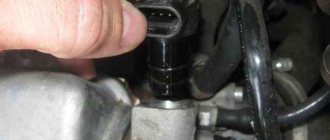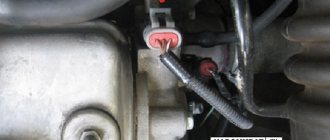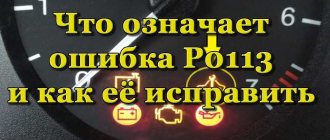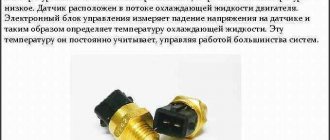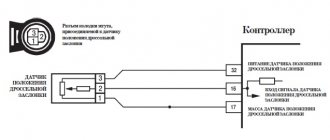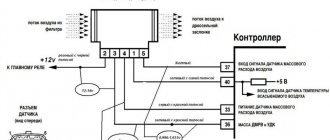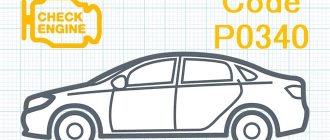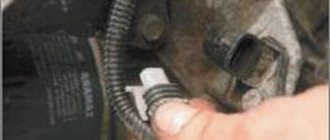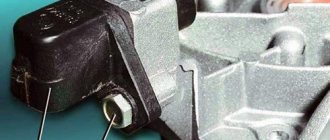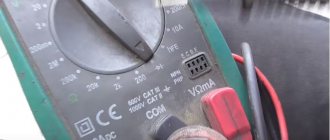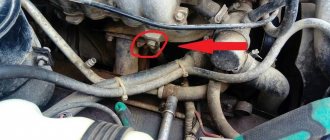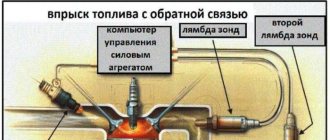Error codes Kalina 8 valves caused by incorrect ignition activation (0300)
- 300 – misfire or no spark for all pistons;
- 301/302/303/304 – similar to the previous number with clarification for each boiler sequentially;
- 325 – problems with the functioning of the DD;
- 327/328 – the mixture detonation sensor does not work correctly;
- 335/336 – failure or incorrect information is received from the DPKV unit;
- 337/338 – similarly with touching ground or other wires;
- 340 – wire break or DRF has failed;
- 342/343/346 – incorrect operation of the phase distribution indicator, possible short circuit;
- 351-354 – poor contact to the ignition coils, or damage to the wiring, for all boilers in series;
- 363 - dry pistons, no gasoline or oxygen, possible blockage or air bubble in the line.
What does error code P0301 mean?
Most gasoline cars have 4-6 cylinder engines. During operation, a spark plug fires sequentially in each cylinder, which ignites the fuel mixture. At the moment of ignition, a micro-explosion occurs, the energy of which is transferred to the crankshaft, which transfers it further to the transmission.
If misfires occur in more than one cylinder, this increases or decreases engine speed. If such fluctuations are 2 percent or more, the engine control unit will record an error code P0300 in its memory.
If the percentage of such fluctuations is in the range from 2 to 10 percent, then the “Check Engine” will light up on the dashboard. If the Check Engine light starts blinking, this indicates that the number of misfires exceeds 10 percent and further operation of the vehicle can lead to serious damage. The P0301 error code indicates that the misfire is occurring in the first cylinder.
Peripheral system used (2000)
- 70-71 – the channel size diagnostic valve is faulty (jammed);
- 100 – break in the PDZ line;
- 101 – similar value to the previous paragraph;
- 102/103 – short circuit of the remote control control line;
- 105 – control unit failure;
- 122/123 – incorrect pedal position signal;
- 127/128 – similar to the above code;
- 187/188 – excessively rich or lean mixture at idle;
- 135 – sensors A and B, designed to control the position of the remote control, do not respond correctly;
- 138 – similar value for the corresponding accelerator lever position sensors;
- 176 – throttle drive position failure;
- 178 – complete failure of adaptation of the above block;
- 187/188 – incorrect mixture formation;
- 270/271 – lack of reaction of DK2 to enrichment or depletion of the mixture after the catalyst;
- 301/304/307/310 – short circuit of the ignition coil for all cylinders, respectively;
- 500/501 – incorrect generator power readings.
Lada Kalina errors, interpretation for automatic transmission (р0000)
- 720 – failure of the output shaft rotation sensor;
- 717 – turbine rotation sensor;
- 705-706 – no selector signal or multiple values;
- 973/974 – solenoid on/off, open circuit or short circuit to ground;
- 962/963 - the same element responsible for pressure - there is a break or short circuit;
- 740/743 – LOCK UP SOL open or closed;
- 17AB/AA – L/C SOL;
- 17АЭ/AD – 2-4/B SOL;
- 17B1/B0 – H/C and L and R/B;
- 1735-1738 – the 1st-4th gear lock is closed, respectively;
- 744/1744 – LU CLUTCH;
- 731-734 – incorrect ratio for positions 1-4;
- 17A0-A4 – reverse and forward gears do not work alternately in accordance with the last digit of the code;
- 711-713 – network malfunction or DTM failure;
- 863 – connection failure with the diagnostic computer;
- 062F – memory error;
- 1701 – main controller power failure.
How to troubleshoot P0301
The cause of the misfire should be fairly easy to determine if the problem is persistent.
Check spark plugs, ignition coils, distributor
Spark plugs can tell you a lot. Signs of sparking on the ignition coil, distributor cap, or rotor may also indicate a faulty part.
A faulty spark plug coil is usually checked by replacing the coils between the cylinders. They look to see if the misfired cylinder has changed or remains the same.
Compression, marks, fuel pressure, lean mixture
Compression, timing marks and fuel pressure can also be checked. The engine may need to be checked for air leaks.
Short-term fuel control (STFT) and long-term fuel control (LTFT) must be checked using a diagnostic scanner or an ELM327 adapter with Torque software. This is necessary to make sure that the air-fuel mixture is not lean.
Often, a faulty mass air flow sensor (MAF) causes the engine to run lean, causing random misfires.
Checking the cooling system pressure can help identify a leaking head gasket.
Exhaust gas recirculation
If the misfire only occurs at idle, the EGR valve and purge valve should be checked as either one may be stuck open.
Valve mechanism
You may need to check your valve adjustments, as out-of-adjustment valves can cause misfire on cold starts, which is a fairly common problem in some older Honda engines.
Faulty valvetrain mechanical parts, such as worn camshaft lobes or a stretched timing chain, can also cause an engine to misfire.
Sometimes a broken or damaged tooth on the crankshaft or camshaft sensor gear can cause a misfire. If you suspect a crankshaft position sensor (CPS) or camshaft position sensor (CPS), checking the signal with an oscilloscope may help.
Once the problem is fixed, the misfire code will disappear after some driving time.
Previous Post Trouble P0131 - Oxygen Sensor Voltage Low (Bank 1 Sensor 1) Next Post Trouble P0341 - Camshaft Position Sensor Range/Performance
Injection engine operation
The normal operation of an internal combustion engine is due to the coordinated action of all components. The fuel combustion process is controlled by an electronic unit. The following systems are used that are responsible for the operation of the injection engine 2115, 2114 models:
- air preparation;
- fuel supply;
- electronic engine control system (ECM);
- ignition;
- gas distribution;
- exhaust;
- cooling;
- engine oil system.
The ECM system for a Priora or VAZ 2115 car is controlled by an electronic control unit (ECU). Stable operation of the unit largely depends on the condition of the sensors. The ECU processes information received from various sources. Based on the analysis, a command is issued to open the injectors.
The camshaft position sensor tells the processor the actual position of the pistons at that moment. The operating principle is based on the Hall effect. When the gear teeth approach the device, an electrical signal appears at the output. In Priora and other cars, the gear is installed on the valve control shaft. It is set on a dowel. One tooth is missing on the camshaft gear.
The depression is placed opposite the sensor. The mark must not be moved. Such positions of the distribution mechanism correspond to the extension of the piston of the first cylinder to top dead center.
When the position of the VAZ 2114 camshaft changes, an alternating magnetic field appears. The sensitive element generates a pulse signal. The ECU counts the number of pulses and issues the necessary commands.
Signs of a faulty phase sensor
If the phase sensor fails completely or partially, the electronic control unit forcibly switches the engine to paraphase fuel injection mode. This means that the timing of fuel injection is carried out according to the readings of the crankshaft sensor. As a result, each fuel injector injects fuel twice as often. This ensures that a fuel-air mixture is formed in each cylinder. However, it is not formed at the most optimal moment, which leads to a drop in engine power, as well as excessive fuel consumption (albeit small, although this depends on the specific engine model).
Symptoms of a faulty phase sensor are:
- fuel consumption increases;
- the toxicity of exhaust gases increases, the smell of exhaust gases will be felt, especially if the catalyst is knocked out;
- the engine begins to operate unstably, most noticeably at low (idle) speeds;
- the acceleration dynamics of the car, as well as the power of its engine, are reduced;
- the Check Engine warning light is activated on the dashboard, and when scanning errors, their numbers will be associated with the phase sensor, for example, error p0340;
- at the moment the engine starts in 3...4 seconds, the starter spins the engine “idling”, after which the engine starts (this is due to the fact that in the first seconds the electronic control unit does not receive any information from the sensor, after which it automatically switches to emergency mode, based on data coming from the crankshaft position sensor).
In addition to the above symptoms, often when the phase sensor fails, problems arise with the vehicle’s self-diagnosis system. In particular, at the moment of starting, the driver is forced to turn the starter for a little more time than usual (usually 6.10 seconds, depending on the model of the car and the engine installed on it). And at this time, self-diagnosis of the electronic control unit occurs, which leads to the formation of corresponding errors and transfer of the engine to emergency operation mode.
Malfunctions of the phase sensor on a car with HBO
It is noted that when the engine is running on gasoline or diesel fuel, the unpleasant symptoms described above do not appear so acutely, which is why many motorists often use cars with a faulty phase sensor for a long time. However, if your car is equipped with gas equipment from the fourth generation and higher (which uses its own “smart” electronics), then the engine will work intermittently, and the driving comfort of the car will sharply decrease.
In particular, fuel consumption will increase significantly, the air-fuel mixture may be lean or, conversely, enriched, and engine power and dynamics will significantly decrease. All this happens due to a mismatch between the software of the electronic engine control unit and the LPG control unit. Accordingly, when using gas-cylinder equipment, the phase sensor must be changed immediately after its breakdown is detected. Using a machine with a damaged camshaft position sensor is harmful in this case not only to the engine, but also directly to the gas equipment and its control system.
Replacing the phase sensor on a Lada Kalina with your own hands
First of all, a little about the tools that will be needed to perform this type of repair. Fortunately, here you can get by with just a 10mm wrench. But it is best to use a socket with a crank, or even more conveniently, a ratchet. It will just be quite inconvenient to do this with a regular key.
First, it’s worth showing clearly where all this is located:
So, first you will need to disconnect the power plug, after first squeezing the plastic latch and lifting it up a little:
Then use a ratchet to unscrew the bolt securing the Kalina phase sensor:
And now you can freely remove it by pulling it towards the windshield:
And this is what this part looks like when removed from the car:
After this, we replace the camshaft sensor and put the new one in its original place. There are absolutely no difficulties during the work process.
Its retail price ranges from 250 to 300 rubles, depending on where you buy it. Of course, this part fails quite rarely on Kalina, but still, these instructions will not hurt anyone.
About the so-called phase sensor on Kalina with 8 cells. 1.6 liter engine. Mileage 180 thousand. The engine is in perfect order. The signal indicating a malfunction of this particular sensor came on (the tester did not detect any more problems). First, CHECK went out after 10-15-20 minutes. drive. Then this time extended to half an hour, an hour. But still - it went out. Now it doesn't go out at all. I've been driving like this for about two to three months. I just did the diagnostics yesterday. Why ? The car has moved! The dynamics have clearly improved in all (.) modes. Fuel consumption decreased from 8.3 to 8.0 liters. The driving mode is standard and does not change from year to year. It is clear that it is now closer to summer, and consumption should decrease. But according to the physics of the matter, if the dynamics can improve, it is really due to an increase in fuel consumption. Reference: the average (multi-month) consumption has never fallen below 8 liters. What kind of standby modes are these that, in fact, seem to be better than the standard one? A friend, an excellent motor mechanic, albeit on marine diesel engines, suggested that due to the lack of afterburning (or whatever) exhaust in the cat. neutralizer - because the standard one has fallen apart, and naturally there is an empty collector in its place - the engine is well fed, everything is good, and everything that it doesn’t need goes straight into the atmosphere, without any extra hassle. Diagnostics does not show a malfunction of the lambda probe. He is the only one in the state, naturally on site. Straight up, miracles. Or would you say, replace this sensor? Should I go even better? But I repeat, the driving mode is absolutely standard and less than 8 liters. Over the 10 years of operation, the display showed very rarely, and not for long.
How does a mechanic diagnose a P0300 code?
When diagnosing this error code, a mechanic will do the following:
- Reads all data and error codes stored in the PCM memory using an OBD-II scanner
- Clear error codes from the PCM memory and test drive the vehicle to see if P0300 appears again
- Determines which cylinders are misfiring
- Check the wires connecting the ignition coils to the spark plugs for wear and damage
- Check spark plugs for wear and damage
- Check the ignition coils, as well as wires and connectors for corrosion and damage
- If necessary, replace spark plugs, ignition coils, as well as related wires and connectors
- If the P0300 code appears again after replacing the above components, check the fuel injector and fuel delivery system
- Check the ignition distributor cap and slider for wear and damage
- If there are other error codes stored in the P0300 code, the PCM will clear any existing errors and test drive the vehicle again to determine if the P0300 error code appears again.
- If the P0300 error appears again, check the compression in the cylinders.
- If the P0300 code persists, the problem may be a faulty PCM. In this case, the module may need to be replaced or reprogrammed.
Common errors when diagnosing code P0300
The most common mistake when diagnosing a P0300 code is to rule out a failed cylinder, fuel injector, or PCM.
It is also a mistake to not look at other error codes that appear along with the P0300 code. If you do not resolve all present errors, this may cause the P0300 code to appear again.
Sensor errors
If symptoms of a faulty phase sensor appear and the engine error icon lights up, it is advisable to diagnose the control system. If you have an on-board computer, then on it you will be able to see errors with numbers 0343 or 0340. But do not rush to change the device immediately, it is quite possible that there is damage to the wires with which it is connected to the computer. Very often the sensor simply becomes dirty, which makes it impossible to read information. But if, after checking the sensor, a malfunction is discovered, you need to purchase a new one and install it. The cost of the device is no more than 600 rubles.
Interruptions in the air supply to the internal combustion engine (0101)
- 102 – damage or malfunction of the mass air flow sensor;
- 103 – short circuit in the MAF wiring;
- 112/13 – failure or incorrect operation of the fuel mixture temperature sensors in the intake manifold;
- 115-116 – violation of antifreeze t° sensors – there is no cooling of the system or the main airflow is not working properly;
- 117-118 – open circuit of the coolant temperature sensor power supply/short circuit;
- 122/123 – defect in cable insulation at the TPS;
- 130/131 – error/break in DC circuit No. 1;
- 132 – short circuit of sensor No. 1 PCV;
- 133/134 – the air sensor connection is broken (sometimes it’s enough to clean the terminals and connector) or the wiring is damaged;
- 135 – malfunction of heater DK2;
- 136 – contact with the body of the DK2 highway;
- 137/138/140 – uncontrolled signal DK2 or break of the corresponding line;
- 141 – failure or interruption of heating of DC2;
- 171/172 - violation of mixture formation in the first case - depletion, for the second - excessive enrichment.
How to Diagnose DTC P0300?
Once a P0300 code is detected, a professional auto mechanic will perform the following steps. You can do the same thing yourself.
Connect your car charger
The charger is extremely important when diagnosing the P0300 code. Because troubleshooting requires that the ignition remain on, and this can lead to battery discharge
As a result, additional error codes will appear, which will complicate the search. A car charger will help preserve your battery's charge.
Connect OBD2 scanner
An OBD2 scanner is required to scan and resolve the P0300 code. With the help of it, you can track the issues related to the error and also troubleshoot them easily.
For cars manufactured before 1996, an OBD1 scanner is used. If the car was manufactured after 1996, use an OBD2 scanner.
Check wiring
Before replacing any part, first make sure all wires and connections are in good condition. Visually inspect the wiring, check for corrosion and correct if necessary.
Check the spark plugs
Spark plugs do not wear out quickly. But if a cylinder is misfiring, it's a good idea to check the spark plugs and notice any signs of trouble.
If the spark plug appears to be faulty, replace it. As part of regular maintenance, you should change the spark plugs every 30,000 km. You should also check the ignition coils!
Inspect the distributor cap
If you replaced the spark plugs, but the problem persists, check the fuel injectors for defects. If you have an old car, check the ignition distributor cap.
Check other error codes
If the OBD2 scanner detects more than one fault code, take the necessary measures to diagnose and resolve them. After doing this, check if the P0300 code returns.
Replace engine control unit
If you have checked everything above, but the error does not go away, there is a possibility that the problem is related to the control unit (PCM). It may need to be re-flashed or replaced.
How to fix the problem?
To fix the problem, you should reset the error and repeat the diagnostics after a couple of days. It is advisable to use an OBD2 scanner. If the code does not disappear, you should check the parts and assemblies of the “four” described above. Sometimes, to eliminate the malfunction, it is enough to clear the sensor of oil and clean the contacts. This procedure can be combined with replacing the timing belt and engine lubricant. In this case, it is useful to eliminate the reason for its contact with an electrical component. If the sensor fails, it should be replaced. Broken or damaged wiring must be repaired. To restore the battery's charge, sometimes it is enough to charge it well with a charger and clean the terminals, but you may need to buy a new battery or repair the generator if the problem is in it.
The ECU, if broken, must be replaced. This is one of the most unpleasant and expensive breakdowns associated with this error. Fortunately, it is rare.
Causes of misfires
Ignition coils
Bad ignition coils are a common problem on many vehicles, including BMW, Ford, Hyundai, Mazda, Nissan, Volkswagen and GM. A faulty ignition coil needs to be replaced.
Candles
If the spark plugs have not been changed for more than 15 thousand km, replacing them would be a good idea. Worn spark plugs require higher voltage to produce a spark, which puts more stress on the ignition coils.
Some car manufacturers update ignition coils during vehicle production.
If one of the ignition coils has failed and the manufacturer has updated the part, then the auto mechanic may recommend replacing all ignition coils with updated ones as a precaution.
Carbon on valves
In many modern vehicles, especially those with direct fuel injection, carbon buildup on the intake valves and injectors can cause misfire.
Some mechanics may recommend cleaning the valves with a special spray or foam, as this is cheaper and sometimes helps. A more effective option is to clean the intake valves manually.
Watch the video on how to clean the valves:
Clogged fuel injectors also need to be cleaned or replaced. This repair is expensive because it requires more labor. It is necessary to remove the intake manifold and some other parts.
Air leak
Vacuum leaks, as well as a stuck EGR valve or purge valve, can cause misfires that mostly occur at idle but go away at higher rpms.
Adjustment of valves
In some older Honda vehicles, misfire can be caused by improperly adjusted valves. The misfire may be more noticeable when the engine is idling after a cold start.
As valve system parts wear, valve clearances change. To compensate for this, the valves in many Honda engines must be adjusted at recommended intervals.
Timing belt
Sometimes an engine may misfire if the timing belt or chain were not correctly aligned when replacing the timing belt. If the problem occurs after replacing the timing belt or chain, the first step is to check the timing marks.
Oil leak
In many high mileage vehicles, oil leaking into the combustion chamber due to worn valve seals and oil rings can foul the spark plugs and cause a misfire.
Often, misfires appear at idle, but disappear after increasing the speed. Blue smoke is another symptom of oil leakage into the combustion chambers.
Water
In many older vehicles, cleaning the engine compartment or driving through deep puddles can cause the engine to misfire as water gets into the ignition parts and causes short circuits.
Replacing the spark plugs and ignition wires often solves the problem. Ignition coils that have cracks or signs of sparking should also be replaced. In older vehicles with an ignition distributor (distributor), the distributor cap and rotor are also replaced.
p1558
This error usually occurs on cars with a 127 engine. It is associated with the throttle valve, the quality of which in this power plant leaves much to be desired. P1558 does not interfere with normal engine operation, but you can still try to fix it. Some people solve the problem by flashing it, but we offer a simpler method.
Remove the throttle valve, and then remove the cover - this can be done using a hexagon. We find a plastic gear inside - this is the working part. Lubricate the gear thoroughly and reassemble in reverse order. Most likely, error p1558 will disappear after these manipulations.
Description of the causes of error P0300
When an engine misfires, high concentrations of hydrocarbons (CH) enter the exhaust pipe. High concentrations of CH can lead to increased exhaust emissions. High concentrations of CH can also cause the temperature of the three-way catalytic converter (TWC) to rise, which in turn can cause damage to the TWC. To prevent this increase in exhaust emissions and limit the potential for thermal damage, the ECM monitors the frequency of misfires. When the temperature of the catalytic converter reaches the thermal breakdown point, the ECM turns on the MIL. The ECM monitors misfires using the crankshaft position sensor (CPS) and camshaft position sensor (CMP). The SMR sensor is used to detect misfiring cylinders, and the SCR sensor is used to measure deviations in crankshaft speed. The number of misfires is counted when the crankshaft speed deviation values exceed preset thresholds. The ECM turns on the MIL and records a DTC if the frequency of misfires exceeds the threshold and may result in increased exhaust emissions.
| DTC No. | DTC Detection Condition | Faulty area |
| P0300 | Simultaneous misfire detected in several cylinders (diagnosis logic for 2 trips) |
|
| P0301P0302P0303P0304 | A misfire was detected in one of the cylinders (diagnosis logic for 2 trips) |
If DTCs are set for different misfired cylinders, but DTC P0300 is not set, it means the misfires were detected and stored at different times. DTC P0300 is set only when misfiring cylinders are detected at the same time.
CONNECTION DIAGRAM
Ignition system connection diagram.
Priora camshaft sensor 16 valves high signal level
- To the beginning of the forum
- Forum Rules
- Old design
- FAQ
- Search
- Users
Good day to all.
Yesterday I stopped at a red light at an intersection, the engine stalled and would not start again. I pulled it on a cord a little so that the on-board vehicle would at least give something out, and I got error 0343. I read about this error and how I realized that with such a problem the engine should start, but it doesn’t work for me at all signs of life. Could this happen if the DPRV is broken? 5 hours before this, this error also came out, but the engine was unstable but somehow worked. I replaced the sensor but bought a slightly different one, for the 15th it was not bought for the eleventh (the engine seems to be the same for them), the numbers on the sensors were different but the engine started working without problems. And then 5 hours later she died.
Added after 21 minutes 24 seconds:
So here’s a check, but it says that you need to start the engine, but it doesn’t start.
Error 0343 – high signal level of the phase sensor circuit The error is entered under the following conditions: 1. The crankshaft is spinning 2. A high signal level is constantly present at terminal “79” of the ECU. The error is entered into the ECU memory on the third drive cycle. Floating error 0343 can be caused by a malfunction of the DF, damage to the wiring harness, unreliable connection of the wiring harness block terminals, or damaged terminals. Check procedure: 1. Turn off the ignition, connect the diagnostic tool, check for errors. 2. If the error is not fixed, see the information above. If the error is not fixed, see the information above. 3. If there is an error, turn off the engine. Undocking the harness block from the DF. We check that the wires are connected correctly to the DF terminals. Turn on the ignition. Using a multimeter, check the voltage between the terminals of the harness block and ground. At terminal “1” - 0 V, terminal “2” should be equal to the onboard voltage, at terminal “3” - 2-3 V less than the onboard voltage. If this is not the case, repair breaks or short circuits in the corresponding circuits. If the wiring is OK, replace the ECU. 4. If at terminal “1” there is 0 V, at terminal “2” there is onboard voltage, at terminal “3” there is 2-3 V less than the onboard voltage, then connect the wiring block to the DF and start the engine. Reset errors. Bring a metal object capable of magnetization to the end of the DF. Check what error is being recorded. If error 0342 appears - there is no metal pin on the camshaft, if error 0343 is detected - replace the DF.
Source
How to replace a spark plug?
Replacing the spark plug is a simple task and you can do it at home. Before changing spark plugs, make sure the engine temperature is low.
Step 1: Open the hood and locate the spark plug
Open the hood and you will see several wires running in the engine compartment. The spark plugs are located in the engine at the end of these wires.
Pull the wire and you will see the spark plug installed.
Step 3: Remove the candle
Insert the spark plug wrench and turn to loosen the spark plug
Remove the old spark plug and note its condition
Step 4. Install a new spark plug
Using the same spark plug wrench, install the new spark plug and tighten it correctly. Then connect the wire as it was before. All is ready.
Symptoms of a faulty camshaft sensor
Just like any part or component in your vehicle, this CMP sensor will eventually, sooner or later, simply stop working due to wear and tear. This happens anyway once its maximum service life has expired. This usually occurs due to wear on the internal wire wrap or a component associated with it.
Usually, in this case, the engine in the car begins to work intermittently, and the signs of a malfunction can vary in different ways, i.e. depending on the type of sensor wear. For example, the same connector in a sensor may wear out, the same internal circuitry in the sensor may fail, or a component associated with the sensor may fail.
On some types of cars, if the camshaft position sensor is faulty, the transmission may be locked in one of the gears and will be locked until you turn off the engine and start it back. This can be repeated with a certain cyclicity.
If the camshaft sensor begins to behave incorrectly while the car is moving, i.e. work, then you can immediately feel that your car has begun to move jerkily and at the same time lose speed.
If the camshaft sensor fails, you may experience a noticeable loss of power from the engine itself. For example, your car simply cannot accelerate over 60 km/h.
The engine in the car may stall intermittently, and all this is due to a malfunction of the CMR sensor.
If the sensor fails, you will notice poor engine performance, it will have a loss of dynamism, misfires will begin when the ignition is turned on, jolts during acceleration, popping noises in the exhaust system, etc. irregularities in work.
On some car models, if the camshaft sensor is faulty, the ignition spark may completely disappear, which will ultimately lead to failure and the engine being unable to start.
After your car's computer detects a malfunction of the camshaft position sensor, which, as you understand, will lead to the appearance (lighting) of the “Check Engine” indicator on the dashboard. After detecting poor operation of the CMR sensor, the computer will automatically record the sensor’s “error code” in its memory. To accurately determine the cause of the malfunction of this camshaft sensor, it is necessary to conduct computer diagnostics of the car, i.e., by thus connecting special equipment to the diagnostic connector of the car. Next, using a special computer program, you can read the “error code”. Below, dear motorists, we present to you a table of diagnostic “error codes” that are directly and directly related to wear on the camshaft sensor.
Additional comments for troubleshooting P0343
The P0343 code usually appears in Chevrolet, Kia, Volkswagen and Hyundai vehicles, usually from 2003-2005. It should also be noted that other error codes related to the camshaft position sensor may appear along with the P0343 code.
Need help with error code P0343?
The company - CarChek, offers a service - on-site computer diagnostics; specialists from our company will come to your home or office to diagnose and identify problems with your car. Find out the cost and sign up for on-site computer diagnostics or contact a consultant by phone
So this time the machine gave me another gift. Why a gift? Yes, because I am a little “addicted” to diagnosing and repairing a car. Someone will say that it is better to drive and just change the oil and not have any problems. I completely agree, but this is very boring! If I wanted it that way, I would buy a foreign car. But who am I kidding, where do I get so much money from? 
So, let's get straight to the problem, but at the beginning.
When error P0300 occurs
The P0300 code appears when the problem is related to the ignition. The error code can be determined in the range P0300-P0312. The code values directly depend on the number of cylinders and the malfunction in each of them. For example, error code 0301 indicates a misfire in the first cylinder, and so on. When checking with a scanner, it will display a warning message about random multiple misfires on the cylinders. If the error is indicated as 0300, the problem is general sparking.
Error code on display
Nevertheless, it is the 300th code that is recorded by the scanner only when there is a failure in sparking in several cylinders at once. The failure is not stored in memory instantly, but only 210 seconds after the next operation at idle; at medium speeds, the error rate should be no less than once every 75 seconds. In this case, an ignition error in several cylinders is indexed only when more than 3.25% of all flashes are missed. If a specific cylinder is to blame, then we will see another version of this code - 0301, 0302 or 0303, if we are dealing with a three-cylinder Daewoo Matiz engine.
Interesting on the topic: The most extravagant cars of rock stars that we didn’t know about
On which cars is this problem most common?
The problem with code P0343 can occur on different machines, but there are always statistics on which brands this error occurs more often. Here is a list of some of them:
- Audi (Audi a4, Audi TT)
- BMW
- Cadillac (Cadillac SRX)
- Chery (Chery Amulet, Jagi, M11, Tiggo)
- Chevrolet (Chevrolet Avalanche, Aveo, Lacetti, Traverse)
- Chrysler
- Citroen (Citroen C4)
- Dodge (Dodge Ram)
- Ford
- Geely (Geely MK)
- Hyundai (Hyundai Accent)
- Kia (Kia Rio, Sportage)
- Lexus
- Mercedes
- Opel (Opel Corsa)
- Peugeot (Peugeot 308)
- Skoda (Skoda Octavia)
- Toyota (Toyota Camry)
- Volkswagen (VW Beatle, Jetta, Passat, Tiguan)
- VAZ 2110, 2111, 2112, 2114, 2115
- Volga Chrysler, 31105
- Gazelle Chrysler, 405
- Lada Vesta, Granta, Kalina, Largus, Niva, Priora
- UAZ Patriot
With fault code P0343, you can sometimes encounter other errors. The most common are: P0030, P0036, P0124, P0332, P0335, P0336, P0340, P0341, P0342, P0345, P0346, P0347, P0348, P0349, P0365, P0366, P0367, P0368, P0369, P039 0, P0391, P0392, P0393 , P0394, P0606, P2122, P2138.
Source
Self-diagnosis
The easiest and most common way to diagnose error codes on a VAZ Kalina is to search using the on-board network. The procedure looks like this.
Insert the key into the lock cylinder. Next, hold down the RESET key and, without releasing it, turn on the ignition. In this case, the device will automatically switch to diagnostic mode. At the same time, all the indications will light up, and the instrument arrows will make a full circle.
You should pay attention to the arrows and indicators - if any diode does not light up, you need to check the device for which the element is responsible. On the right steering column lever there is a button for scrolling through the options - you need to scroll to the required position (error codes). Next, the display will show the general error number; to reset the index, you need to hold RES for three seconds.
Note! The indicated sequence is relevant for Lada Kalina of the first and second modifications.
The position of the error codes will show one of the indices on the display:
- “2” – there is a surge in the BS power supply – a possible short circuit in the wiring;
- “3” – rupture of lines, or failure of the float inside the gas tank;
- error 4 Lada Kalina says that the coolant temperature sensor is broken or malfunctioning;
- “5” – the thermometer has gone astray, the element may be damaged or the circuit may be broken;
- “6” – exceeding the maximum permissible temperature of the internal combustion engine block, while the acoustic alarm is working;
- “7” – exceeding the permissible pressure thresholds inside the oil line;
- “8” - on a Lada Kalina car, error 8 appears when there is a malfunction of the calipers or a breakdown in the hydraulic drive line;
- “9” – critical voltage drop in the battery;
- “E” – incorrect reading or display of the EEPROM information module.
To return to the original part, it is enough to hold RES for 30 s. The disadvantage of this method is minimal accuracy - the procedure shows in which direction to look for a breakdown, but not a specific node. So, it is possible to understand exactly where the failure occurred only by the following method.
Replacing the device
If the device breaks down, there is no point in repairing it. It is much easier to replace the phase sensor, fortunately you will spend a few minutes on it. To carry out repairs you need a 10 mm socket and a ratchet. The procedure looks like this:
- Disconnect the negative terminal from the battery.
- Unscrew the sensor fixing bolt on the engine block and disconnect the block with which it is connected to the electrics.
- Clean all contacts on the block and install a new sensor.
If the wiring is completely intact and there were no problems during installation, all errors will disappear on the on-board computer. The engine will switch to phased injection mode.
Causes of error P0300
- Worn or damaged spark plugs
- Worn or damaged spark plug wires and/or ignition coils
- Damage to the distributor cap (if equipped)
- Worn or damaged ignition distributor runner (if equipped)
- Fuel injector damage
- Clogged pipes or valve of the exhaust gas recirculation system
- Incorrect ignition timing setting
- Vacuum leak
- Low fuel pressure
- Damage to the cylinder head gasket
- Distributor cap wear
- Camshaft position sensor malfunction
- Malfunction of the crankshaft position sensor
- Air flow sensor malfunction
- Oxygen sensor malfunction
- Throttle Position Sensor Malfunction
- Malfunction of the catalytic converter
- PCM malfunction
What Causes Code P0301
- spark plug of cylinder 1 is damaged or worn
- Damaged or worn spark plug wire and/or ignition coil
- The ignition distributor cap is damaged or worn.
- the “slider” of the distributor (ignition distributor) is damaged or worn out
- Fuel injector of cylinder 1 is dirty or damaged
- The EGR valve tubes or the valve itself are clogged
- Incorrect ignition timing (late or early ignition)
- leakage of vacuum tubes
- low fuel pressure
- Damaged cylinder head gasket(s)
- distributor cap is cracked
- camshaft position sensor faulty
- crankshaft position sensor is faulty
- The mass air flow sensor (MAF sensor) is faulty
- faulty oxygen sensor (lambda probe)
- Throttle position sensor is faulty
- the catalytic converter (catalyst) is faulty
- faulty engine control unit
What does P0301 mean?
P0301 (and other P030X codes such as P0302, P0303, etc.) are simpler than you might expect. Because the ECU has already determined which cylinder has the problem, saving you the diagnostic headache.
The last digit of the P030X code indicates the number of the misfired cylinder. P0302 is a misfire on cylinder 2, P0303 is on cylinder 3, and so on.
The P0300 code indicates a random misfire. This means that several cylinders are misfiring randomly. Codes P0300 through P0308 are called misfire codes.
If you have one of these errors, you need to fix the problem as quickly as possible. If you drive your vehicle in this condition, you will damage the catalytic converter.
